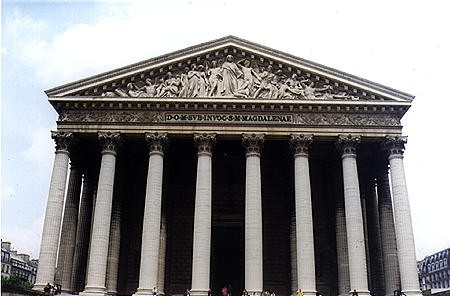There has been a church in this area since the 13th century when the neighbourhood was known as Ville l'Evêque and its church was Sainte-Marie-Madeleine, situated at the end of the present-day boulevard Malesherbes. In the 18th century a new building was deemed necessary in view of the recent growth in the population of the area. Pierre Constant d'Ivry drew up the plans for the structure. The aim was to produce a church worthy of its site on the monumental perspective of rue Royale and place Louis XV. On Constant's death in 1777 the plans were modified by Guillaume Couture but the Revolution stopped construction work in 1791.
In 1802 the signing of the Concordat restored Catholicism to France, however the newly created parish of the Madeleine was centred not on the unfinished building but on the Church of the Assumption in rue Saint-Honoré. Furthermore, the purpose for the site begun by Couture was no longer clearly understood. Consequently, many alternative schemes were put forward, the one accepted being that by Pierre Vignon. In accordance with an imperial decree of February 1806 Vignon's project was to develop the half-built structure into a Stock Exchange, a commercial tribunal as well as the Bank of France.
However, another imperial decree signed by Napoleon at the Posen Camp on the symbolic date of 2nd December, 1806 cancelled the previous decree and advertised a competition for “the building of a temple to the glory of the French army on the site of the Madeleine”. The building programme included the addition of an inscription in the pediment which read “L'Empereur Napoléon aux soldats de la Grande Armée”, as well as on the inside the addition of marble tablets on which were inscribed the names of all the men (arranged in order of army corps and regiment) who had fought at the battles of Ulm, Austerlitz and Iéna. Those who had died on these battlefields were to have their names inscribed in solid gold tablets – there was also to be another list of all the soldiers, this time listed according to their different home departments, these on tablets of silver. To complete this memorial there were to have been bas-reliefs showing the regiments of the Grand Army, statues of the Maréchals and all their trophies, and the “flags, standards and drums” taken from the enemy.
Eighty artists entered the competition which was won by Etienne de Beaumont. But the Emperor nevertheless decided to award the project to Vignon: “I wanted a temple not a church” was his furious comment on Beaumont's design. Vignon then set about demolishing what had been built by Couture – this took until 1811. When the major work finally started it progressed only very slowly owing to shortage of funds. After the Russian Campaign, Napoleon abandoned completely the idea of a Temple of Glory and began to reconsider the idea for a church. With the fall of the Empire work stopped once again.
It was the Restoration which re-launched the project, giving the construction back to the Catholic church and consecrating it to the memory of the Royal family who climbed the scaffold to their deaths close to that spot during the Revolution. Vignon once again directed the work beginning in 1816, but on his death in 1828 this was taken over by Huvée. In 1842 the church was made once again the principal parish of the 1st arrondissement, and it was consecrated by the Archbishop of Paris in 1845.
A peripteral temple with Corinthian columns, the Madeleine is one of the best examples of Neo-classical architecture in Paris. It marks Napoleon's express wish to bring back the grandeur of antiquity in celebration “of the memory of the immortal glory of the Emperor…and that of his companions in arms”. Although nothing of the original Napoleonic programme for the sculptural decoration of the church remains, nevertheless there are many exceptional works within the church, notably the monumental bronze doors by Triqueti and the “Baptism of Christ” by Rude. Of particular interest is the fresco in the semi-cupola of the apse produced by Ziegler representing the glorious history of Christianity (1835-1837). This work, the only fresco in a Parisian church to include a figure of Napoleon, shows Christ surrounded by Mary Magdelene, the Apostles and the great figures of Christianity, namely Constantine, Clovis, Godefroy de Bouillon, Frederick Barbarossa, Joan of Arc, Dante, Raphael, Pius VII and the Emperor in his coronation robes.
Church of the Madeleine


